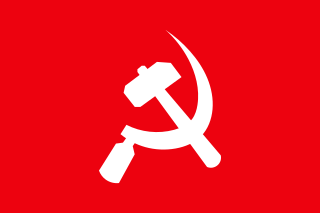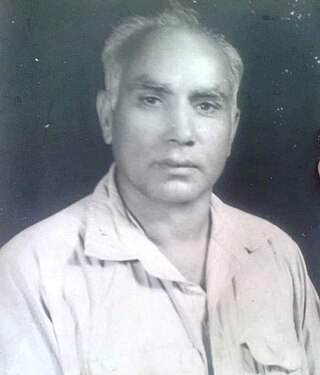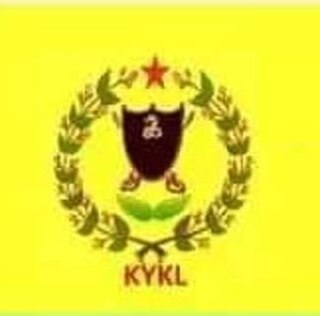
The hammer and sickle is a communist symbol representing proletarian solidarity between agricultural and industrial workers. It was first adopted during the Russian Revolution at the end of World War I, the hammer representing workers and the sickle representing the peasants.

The Communist Party of India (CPI) is the oldest communist party in India. The CPI was founded in modern-day Kanpur on 26 December 1925.

Communist Party of India (Marxist–Leninist) Janashakti, abbreviated CPI (ML) Janashakti, was a communist political party in India. In 2013, CPI (ML) Jansakthi merged into CPIML.

Unity Centre of Communist Revolutionaries of India (Marxist–Leninist) was created through the merger of Andhra Pradesh Coordination Committee of Communist Revolutionaries, Northern Zone Committee RCUC(M-L), West Bengal Communist Unity Centre and West Bengal Co-ordination Committee of Revolutionaries (WBCCR). The formation took place at a unity conference in April 1975. The unity conference adopted a resolution on martyrs, programme, path, method of work, constitution and a statement on unification. The unity conference elected a Central Committee with Devulapalli Venkateswara Rao as its secretary. UCCRI(ML) had as its ambition to unite all communist revolutionary forces, including people within the Communist Party of India (Marxist-Leninist) fold. UCCRI(ML) started publishing the SPARK as its central organ.
Communist Party of India (Marxist–Leninist) Central Team was formed in 1977 when activists from Punjab, Maharashtra and West Bengal of Communist Party of India (Marxist–Leninist) of Satyanaryan Singh revolted against the party leadership. CPI(ML) Central Team reaffirmed the legacy of Charu Majumdar.

The Revolutionary Workers Party of Bangladesh is a political party in Bangladesh, founded on 14 June 2004 after splitting from the Workers Party of Bangladesh due to disagreements regarding joint actions with the Awami League. The party initially used the name "Workers Party of Bangladesh" briefly after its founding. The party president is Khandaker Ali Abbas and the general secretary is Saiful Haque.

The Coordination Committee of Maoist Parties and Organizations of South Asia (CCOMPOSA) was an umbrella organization of various South Asian Maoist parties and movements and its purpose is to coordinate their activities throughout South Asia.

Ambika Chakrabarty was an Indian independence movement activist and revolutionary. Later, he was a leader of the Communist Party of India and a member of the West Bengal Legislative Assembly.
Niranjan Sengupta was a Bengali Indian revolutionary and freedom fighter. He was a leader of Communist Party of India (Marxist).He was born in Jhalokathi district of Barisal.
The United Left Front was an electoral alliance in West Bengal, India, formed in December 1966, ahead of the 1967 West Bengal Legislative Assembly election. The front comprised the Communist Party of India (Marxist), the Samyukta Socialist Party, the Socialist Unity Centre of India, the Marxist Forward Bloc, the Revolutionary Communist Party of India, the Workers Party of India and the Revolutionary Socialist Party. The front won 63 seats out of 280. After the election ULF merged with the People's United Left Front, forming the United Front. The UF formed a state government, dislodging the Indian National Congress for the first time in the state.
Confederation of Indian Communist and Democratic Socialists (CICDS) was a confederation of left-wing parties in India.
In Mao Zedong's original formulation of the military strategy of people's war, a revolutionary base area, or simply base area, is a local stronghold that the revolutionary force conducting the people's war should attempt to establish, starting from a remote area with mountainous or forested terrain in which its enemy is weak.

Hare Krishna Konar was an Indian Marxist revolutionary, agricultural theorist, charismatic peasant leader and politician. Konar was a founding member of the Communist Party of India (Marxist), the figurehead behind India's first land reform, and the chief architect of the West Bengal land distribution. Between the 1960s and 1970s, he became one of the principal leaders of the Communist movements in India. In 1932, due to his involvement in the Begut Robbery Case of the Jugantar Party, Konar was deported to the Cellular Jail of the Andamans for 6 years at the age of 18. There he took part in the first hunger strike, and in 1935 he founded the Communist Consolidation and led the historical second hunger strike.

Pandit Kishori Lal was a communist Indian revolutionary from Punjab who worked with Sukhdev Thapar and the Hindustan Socialist Republican Association (HSRA).

Kanglei Yawol Kanna Lup is a Meitei insurgent group that operates in the state of Manipur in India. It was formed in January 1994 by a faction of the United National Liberation Front (UNLF) led by Namoijam Oken in conjunction with splinter groups of Kangleipak Communist Party (KCP) and People's Revolutionary Party of Kangleipak (PREPAK). It is a secessionist organisation and banned by the Government of India. The group displays a strong ethnonationalist and nativist rhetoric in their announcements.
Marxism–Leninism–Maoism (MLM) is a political philosophy that synthesizes and builds upon Marxism–Leninism and the thought of Mao Zedong. Marxism–Leninism–Maoism was first formalized by the Shining Path in 1982.
The Revolutionary Internationalist Movement (RIM) was an international communist organization founded in France in March 1984 by 17 various Maoist organizations around the world. It sought to "struggle for the formation of a Communist International of a new type, based on Marxism–Leninism–Maoism". The RIM appears to be defunct as are many of the founding organizations and many changed their names over the years, or have dropped active armed struggle.
A united front is an alliance of groups against their common enemies, figuratively evoking unification of previously separate geographic fronts and/or unification of previously separate armies into a front. The name often refers to a political and/or military struggle carried out by revolutionaries, especially in revolutionary socialism, communism, or anarchism. The basic theory of the united front tactic among socialists was first developed by the Communist International, an international communist organization created by communists in the wake of the October Revolution. According to the thesis of the 1922 4th World Congress of the Communist International:
The united front tactic is simply an initiative whereby the communists propose to join with all workers belonging to other parties and groups and all unaligned workers in a common struggle to defend the immediate, basic interests of the working class against the bourgeoisie.
This page is based on this
Wikipedia article Text is available under the
CC BY-SA 4.0 license; additional terms may apply.
Images, videos and audio are available under their respective licenses.







